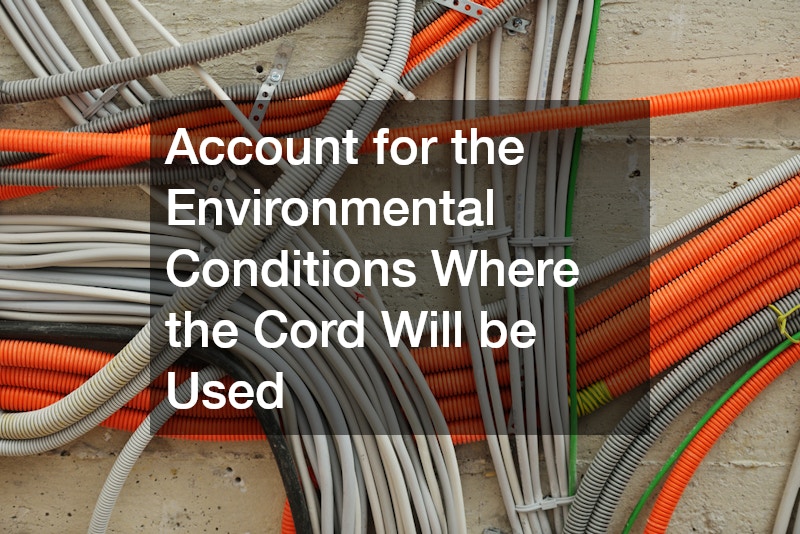In any project involving electrical or mechanical tasks, selecting the right cord is crucial to ensure safety and efficiency. Whether you’re a DIY enthusiast or a professional tradesperson, knowing the difference between standard and heavy-duty cords could be pivotal for your work’s success. This article aims to delve into the types of cords available, focusing predominantly on the usage and importance of heavy duty cords.
Understanding the Basics: Types of Cords
The first step in ensuring you’re using the correct cord for your project is understanding the various types available. Generally, cords can be classified into three main categories: light-duty, medium-duty, and heavy-duty cords.
Each type serves distinct purposes, with varying capacities for carrying electrical load and withstanding environmental conditions.
Light-duty cords are suitable for low-power appliances and indoor use. They are usually less expensive and more flexible, making them ideal for short-term projects that do not require high power output. However, their limitations include lower durability and restricted usage in harsher environments, which could pose a safety risk if used improperly.
Medium-duty cords bridge the gap between light and heavy-duty cords, offering a balance of durability and flexibility. These cords can handle moderate power loads, making them appropriate for general indoor and some light outdoor tasks. Nevertheless, when faced with heavy machinery or power tools, these cords may not suffice, requiring an upgrade to a more robust cord type.
The Importance of Heavy-Duty Cords
Heavy-duty cords are specifically engineered to handle high-power tasks, making them indispensable for demanding projects. They are constructed using thicker insulation and more durable materials, allowing them to withstand harsh environments and prevent overheating. This makes them perfect for use with power tools, large appliances, and outdoor projects where exposure to the elements is a concern.
One key advantage of heavy duty cords is their ability to maintain power integrity over longer distances. This means they can deliver consistent electrical output to your equipment, minimizing voltage drop and energy loss. Consequently, using a heavy duty cord not only enhances performance but also contributes to energy efficiency, safeguarding the longevity of your tools and appliances.
Additionally, heavy-duty cords offer superior safety features compared to their lighter counterparts. Their robust design reduces the risks associated with wire breakage, melting, and accidental disconnections, which are common hazards in high-load applications. Furthermore, many heavy-duty cords come equipped with ground fault circuit interrupter (GFCI) plugs, providing an extra layer of protection against electrical shocks.
Choosing the Right Heavy Duty Cord for Your Needs
Selecting the appropriate heavy duty cord involves more than simply picking any option labeled as ‘heavy duty.’ It’s vital to consider factors such as the cord’s gauge, length, and the environment in which it will be used. Understanding the American Wire Gauge (AWG) system is important, as it determines the cord’s capacity to carry electric current. A lower AWG number signifies a thicker wire, which in turn supports higher power loads.
The length of the cord is another crucial consideration. While longer cords provide greater reach, they also contribute to greater power drop, especially if the gauge is not suited for the distance. Therefore, it’s important to match the cord’s length with its gauge to ensure optimal performance without sacrificing safety or efficiency.
Finally, account for the environmental conditions where the cord will be used. For instance, cords labeled for outdoor use are designed to withstand exposure to elements such as moisture and UV rays. Using indoor cords outdoors can lead to premature wear and potential safety hazards. Always verify that your heavy-duty cord is rated for the intended environment to avoid complications.
Tips for Maintaining and Storing Heavy-Duty Cords
Proper maintenance and storage of heavy-duty cords can significantly prolong their lifespan and maximize their efficiency. Begin by ensuring cords are coiled neatly after use, reducing the chance of kinks and tangles that can damage the internal wires. When winding the cord, avoid tight loops, which can put stress on the insulation and cause breakage.
Inspect your heavy duty cords regularly for signs of wear, such as fraying, cracks, or exposed wires. Early detection of such issues can prevent accidents and extend the life of your cords. Replace damaged cords immediately, as attempting to repair them with tape or makeshift solutions can compromise the cord’s safety and effectiveness.
Store heavy duty cords in a dry, cool place away from direct sunlight and extreme temperatures. Exposure to harsh conditions can degrade the cord’s material and reduce its performance over time. Consider using a cord rack or hooks to keep cords off the ground, preventing them from collecting dust or moisture that can contribute to material breakdown.
In any project involving electrical or mechanical tasks, selecting the right cord is crucial to ensure safety and efficiency. Whether you’re a DIY enthusiast or a professional tradesperson, knowing the difference between standard and heavy-duty cords could be pivotal for your work’s success. This article aims to delve into the types of cords available, focusing predominantly on the usage and importance of heavy duty cords.
Understanding the Basics: Types of Cords
The first step in ensuring you’re using the correct cord for your project is understanding the various types available. Generally, cords can be classified into three main categories: light-duty, medium-duty, and heavy-duty cords.
Each type serves distinct purposes, with varying capacities for carrying electrical load and withstanding environmental conditions.
Light-duty cords are suitable for low-power appliances and indoor use. They are usually less expensive and more flexible, making them ideal for short-term projects that do not require high power output. However, their limitations include lower durability and restricted usage in harsher environments, which could pose a safety risk if used improperly.
Medium-duty cords bridge the gap between light and heavy-duty cords, offering a balance of durability and flexibility. These cords can handle moderate power loads, making them appropriate for general indoor and some light outdoor tasks. Nevertheless, when faced with heavy machinery or power tools, these cords may not suffice, requiring an upgrade to a more robust cord type.
The Importance of Heavy-Duty Cords
Heavy-duty cords are specifically engineered to handle high-power tasks, making them indispensable for demanding projects. They are constructed using thicker insulation and more durable materials, allowing them to withstand harsh environments and prevent overheating. This makes them perfect for use with power tools, large appliances, and outdoor projects where exposure to the elements is a concern.
One key advantage of heavy duty cords is their ability to maintain power integrity over longer distances. This means they can deliver consistent electrical output to your equipment, minimizing voltage drop and energy loss. Consequently, using a heavy duty cord not only enhances performance but also contributes to energy efficiency, safeguarding the longevity of your tools and appliances.
Additionally, heavy-duty cords offer superior safety features compared to their lighter counterparts. Their robust design reduces the risks associated with wire breakage, melting, and accidental disconnections, which are common hazards in high-load applications. Furthermore, many heavy-duty cords come equipped with ground fault circuit interrupter (GFCI) plugs, providing an extra layer of protection against electrical shocks.
Choosing the Right Heavy Duty Cord for Your Needs
Selecting the appropriate heavy duty cord involves more than simply picking any option labeled as ‘heavy duty.’ It’s vital to consider factors such as the cord’s gauge, length, and the environment in which it will be used. Understanding the American Wire Gauge (AWG) system is important, as it determines the cord’s capacity to carry electric current. A lower AWG number signifies a thicker wire, which in turn supports higher power loads.
The length of the cord is another crucial consideration. While longer cords provide greater reach, they also contribute to greater power drop, especially if the gauge is not suited for the distance. Therefore, it’s important to match the cord’s length with its gauge to ensure optimal performance without sacrificing safety or efficiency.
Finally, account for the environmental conditions where the cord will be used. For instance, cords labeled for outdoor use are designed to withstand exposure to elements such as moisture and UV rays. Using indoor cords outdoors can lead to premature wear and potential safety hazards. Always verify that your heavy-duty cord is rated for the intended environment to avoid complications.
Tips for Maintaining and Storing Heavy-Duty Cords
Proper maintenance and storage of heavy-duty cords can significantly prolong their lifespan and maximize their efficiency. Begin by ensuring cords are coiled neatly after use, reducing the chance of kinks and tangles that can damage the internal wires. When winding the cord, avoid tight loops, which can put stress on the insulation and cause breakage.
Inspect your heavy duty cords regularly for signs of wear, such as fraying, cracks, or exposed wires. Early detection of such issues can prevent accidents and extend the life of your cords. Replace damaged cords immediately, as attempting to repair them with tape or makeshift solutions can compromise the cord’s safety and effectiveness.
Store heavy duty cords in a dry, cool place away from direct sunlight and extreme temperatures. Exposure to harsh conditions can degrade the cord’s material and reduce its performance over time. Consider using a cord rack or hooks to keep cords off the ground, preventing them from collecting dust or moisture that can contribute to material breakdown.




